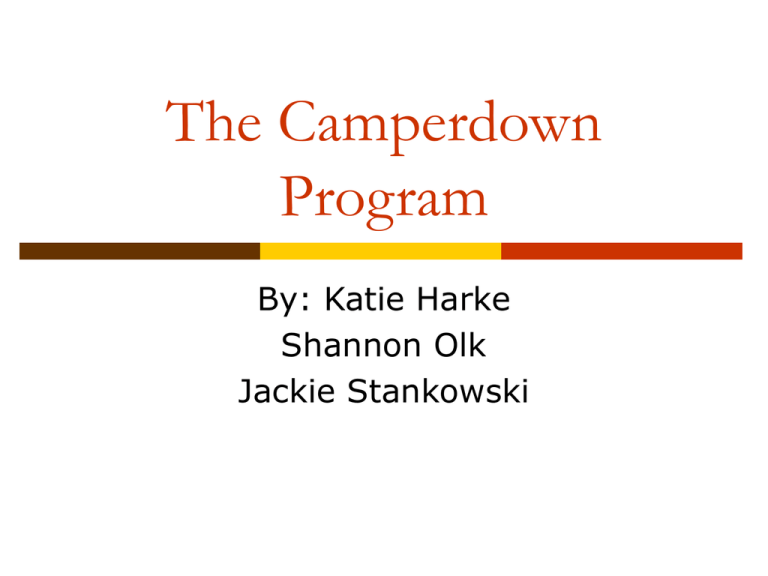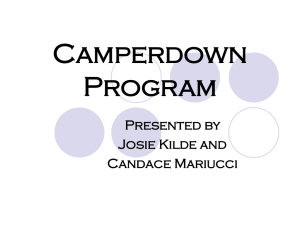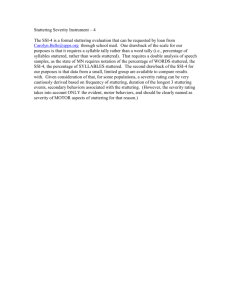The Camperdown Program By: Katie Harke Shannon Olk
advertisement

The Camperdown Program By: Katie Harke Shannon Olk Jackie Stankowski Underlying Process/Rationale Adult treatment program Use Prolonged Speech (PS) aspects • • • • • • Reduced speech rate Continuous or extended vocalizations Prolonged words or sounds Soft articulatory contacts Gentle onset of speech and/or voice Breath stream management Overall goal is to reduce stuttering using any strategy of PS that best suits them while also sounding as natural as possible A fluency shaping approach Four Stages 1. Individual Teaching Sessions 2. Group Practice Session 3. Individual Problem Solving Sessions 4. Performance Contingent Maintenance Stage Individual Teaching Sessions Done one-on-one, for 3-5 sessions The client learns how to produce PS by watching a video with exaggerated samples Client evaluates his/her severity Client listens to speech samples and rates them Individual Teaching Sessions Continued The clinician gives feedback without reference to specific targets The client moves to stage 2 when their rating is at 2 or less and can produce stutter free speech for 3 minutes 1-9 scale for severity and naturalness 1=no stuttering/highly natural 9= severe stuttering/ highly unnatural Group Practice Session 1 session (8 hours) with a series of 14 cycles involving 3 phases: Practicing unnatural speech pattern as in video Speaking in monologue using PS pattern. Aim to achieve naturalness of 1-3 and severity of 1-2 over several sessions Evaluating speech produced in the previous phase for stuttering and naturalness Usually 3 clients and 3 clinicians Learn to gain control naturally Individual Problem Solving Sessions One hour weekly, following the group practice day Develop strategies to generalize stutter free speech Individualized practice Analyzing situations in which control of stuttering is difficult Client moves to stage 4 when: One 10 minute within-clinic conversation with severity of 1-2 and naturalness rating of 1-3 Three 10 minute beyond-clinic recorded conversations with severity of 1-2 and naturalness rating of 1-3 Must reach criteria for 3 consecutive weeks in the beyond-clinic recordings Performance-Contingent Maintenance Stage Steps scheduled at interval of: 2 weeks, 2 weeks, 4 weeks, 4 weeks, 8 weeks, 12 weeks, and 24 weeks Failure to meet criteria in any step requires that step to be repeated Research Data: 12 months post treatment Overall, speech outcome data was favorable Stuttering severity was low- speakers spoke with minimal stuttering Speech naturalness rates averaged 4.5 with a range of 1.3-7.3 Speech rates were within normal range Some sign of relapse in 3 of the 16 participants within 6-12 months post treatment Strengths & Weaknesses Strengths: Individualized Incorporates self-evaluation techniques Responsibility for managing and controlling stuttering is transferred to the client Clinical hours reduced: real-world experiences increases generalization Non-programmed and instrument free Weaknesses: Client accountability: client is responsible for therapy Perceived naturalness is low between speakers and listeners Would We Recommend it? Yes It is highly individualized Provides the client unlimited opportunities to practice – this promotes generalization Promotes self-evaluation and self-awareness – minimizes clinician’s criticisms Materials are provided for client reference (video and Manual) However: Some speakers and listeners report that this method results in noticeably unnatural speech. It is one of many options available to a client that can be considered. References Schaffer, Natalie (2006). Effects of differential prolongations of phrases on the perceptions of speech naturalness. Contemporary Issues in Communication Sciences and Disorders, 33, 152-159. O’Brian, S., Onslow, M., Cream, A., & Packman, A., (2003). The camperdown program: outcomes of a new prolonged speech treatment model. Journal of Speech, language, and Hearing Research, 46, 933946. The Camperdown Program Treatment Manual (2003). ASRC. Retrieved from http://www3.fhs.usyd.edu.au/asrcwww/downloads/Camper down_Tmt_Manual.pdf



